
Eucalyptus rubida, commonly known as candlebark, ribbon gum or white gum, is a species of small to medium-sized tree that is endemic to south-eastern Australia. It has smooth bark, sometimes with rough bark at the base, lance-shaped or curved adult leaves, flower buds in groups of three, white flowers and cup-shaped, hemispherical or bell-shaped fruit.

Eucalyptus caliginosa, commonly known as broad-leaved stringybark or New England stringybark, is a tree that is endemic to eastern Australia. It has stringy bark, lance-shaped or curved adult leaves, flower buds in groups of seven or nine, white flowers and more or less hemispherical fruit. It is common on the Northern Tablelands and North West Slopes of New South Wales and adjacent areas of Queensland.

Eucalyptus scias, known as the large-fruited red mahogany, is a species of small, straggly to medium-sized tree that is endemic to the high rainfall coastal areas of New South Wales. It has rough, fibrous bark on the trunk and branches, lance-shaped adult leaves, flower buds in groups of three or seven, white flowers and cup-shaped, conical or bell-shaped fruit.

Eucalyptus agglomerata, commonly known as blue-leaved stringybark, is a tree endemic to eastern Australia. It has persistent, stringy bark, green or greyish leaves with a bluish sheen, flower buds in groups of eleven to fifteen, white to cream-coloured flowers and crowded, flattened hemispherical fruit.

Eucalyptus parvula, commonly known as small-leaved gum, is a species of small tree that is endemic to south-eastern New South Wales. It has mostly smooth bark, elliptical to lance-shaped adult leaves but with many juvenile of intermediate leaves in the crown, flower buds in groups of seven, white flowers and cup-shaped fruit.

Corymbia henryi, commonly known as the large-leaved spotted gum, is a species of small to medium-sized tree that is endemic to north-eastern Australia. It has smooth, mottled bark, lance-shaped adult leaves, flower buds in groups of three, white or lemon yellow flowers and barrel-shaped to urn-shaped fruit.
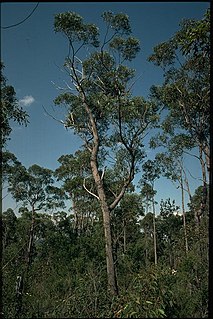
Eucalyptus sparsifolia, commonly known as the narrow-leaved stringybark, is a tree endemic to New South Wales. It has grey to reddish brown, stringy bark, glossy green lance-shaped leaves, spindle-shaped flower buds and more or less spherical fruit.

Eucalyptus tenella, commonly known as narrow-leaved stringybark, is a species of small to medium-sized tree that is endemic to New South Wales. It has stringy bark, narrow lance-shaped to linear leaves, flower buds in group of seven to fifteen, white flowers and hemispherical fruit.
Eucalyptus × conjuncta is a species of flowering plant that is endemic to a small area of New South Wales. It is a tree with rough stringy bark, lance-shaped adult leaves, flower buds in groups of eleven or more, white flowers and cup-shaped or hemispherical fruit. It is considered to be a stabilised hybrid between E. eugenioides and E. sparsifolia.
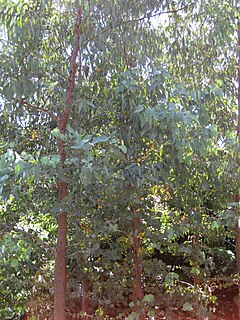
Eucalyptus alligatrix, commonly known as the silver stringybark, is a tree endemic to southeastern Australia. It has rough, fibrous bark on the trunk and branches, lance-shaped adult leaves, flower buds usually arranged in groups of three, white flowers and cup-shaped, bell-shaped or cone-shaped fruit.

Eucalyptus aquatica, commonly known as broad-leaved sally, or mountain swamp gum is a tree or mallee that is endemic to a small area of New South Wales in eastern Australia. It has smooth, greyish bark, dull bluish green adult leaves, flower buds arranged in groups of seven, white flowers and conical or hemispherical fruit. It grows in swamps and other places with poor drainage.
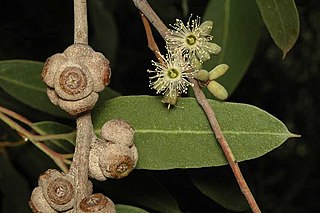
Eucalyptus bensonii, commonly known as Benson's stringybark, is a small tree or mallee that is endemic to New South Wales. It has rough grey or brown stringy bark on the trunk and larger branches, smooth bark on the thinnest branches, broadly lance-shaped to egg-shaped adult leaves, flower buds arranged in groups of seven, nine or eleven, white flowers and cup-shaped or hemispherical fruit in clusters.

Eucalyptus boliviana, commonly known as Bolivia Hill stringybark or Bolivia stringybark is a shrub or a mallee, sometimes a small tree and is endemic to a small area in northern New South Wales. It is a stringybark with four-sides stems, broadly lance-shaped adult leaves, flower buds arranged in groups of seven, yellow flowers and hemispherical to broadly funnel-shaped fruit.
Eucalyptus interstans is a species of small to medium-sized tree endemic to New South Wales and Queensland. It has smooth white or greyish bark, lance-shaped or curved adult leaves, flower buds in groups of between seven and eleven, white flowers and cup-shaped to hemispherical fruit.
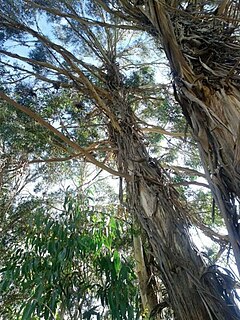
Eucalyptus nobilis, commonly known as ribbon gum or giant white gum, is a species of medium to tall tree that is native to northern New South Wales and south-east Queensland. It has a long, straight trunk with smooth, greyish bark that is shed in long ribbons, lance-shaped or curved adult leaves, flower buds in groups of seven, white flowers and cup-shaped or hemispherical fruit.
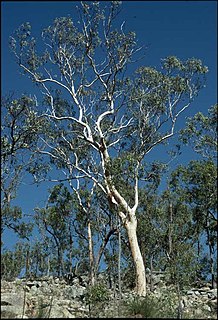
Eucalyptus pachycalyx, commonly known as the shiny-barked gum, is a species of tree that is endemic to north-eastern Australia. It has smooth, pale grey, mottled bark, lance-shaped or curved adult leaves, white flowers and cup-shaped or hemispherical fruit.
Eucalyptus retinens, commonly known as Hillgrove box, is a species of tree that is endemic to the Northern Tablelands of New South Wales. It has rough, fibrous or flaky bark on the trunk and larger branches, smooth bark on the thinner branches, lance-shaped adult leaves, flower buds in groups of seven, white flowers and cup-shaped, cylindrical or hemispherical fruit.

Eucalyptus camfieldii, commonly known as Camfield's stringybark or heart-leaved stringybark, is a species of mallee or small tree that is endemic to New South Wales. It has rough, fibrous and stringy bark, broadly lance-shaped adult leaves, flower buds in groups of about eleven, white flowers and flattened hemispherical fruit. It grows in poor, sandy soil in the Sydney region.
Eucalyptus atrata, commonly known as the Herberton ironbark or blue-leaved ironbark, is a small tree that is endemic to Queensland. It has hard, black "ironbark" on the trunk and all but the thinnest branches, lance-shaped adult leaves, buds usually arranged in groups of seven, white flowers and cup-shaped to hemispherical fruit. It is characterised by the blue-grey, powdery bloom on its leaves and flower buds.
Eucalyptus imitans, commonly known as the Illawarra stringybark, is a species of small tree that is endemic to New South Wales. It has rough, stringy, greyish bark on the trunk and larger branches, lance-shaped, elliptic to egg-shaped or curved adult leaves, flower buds in groups of between nine and fifteen, white flowers and hemispherical fruit. It is found on near-coastal tablelands inland from the south coast.















